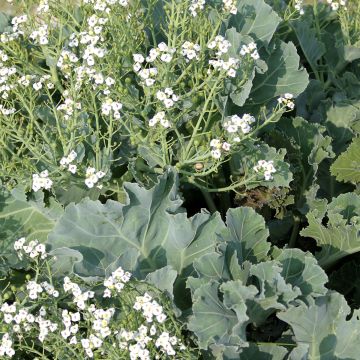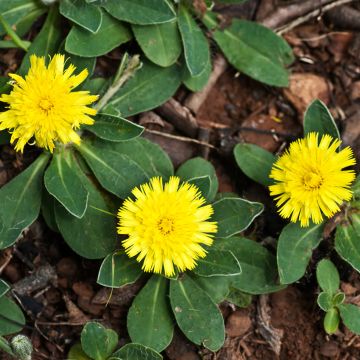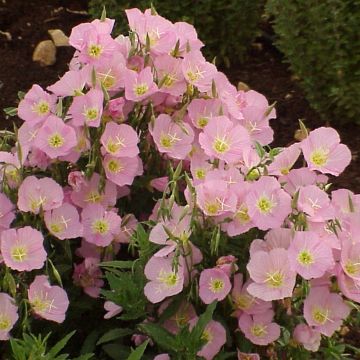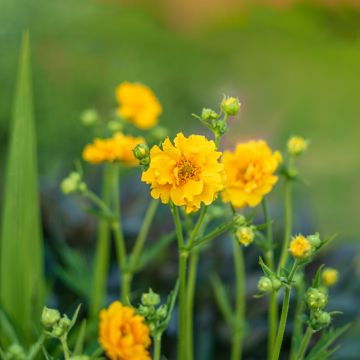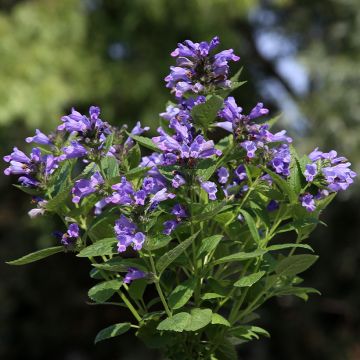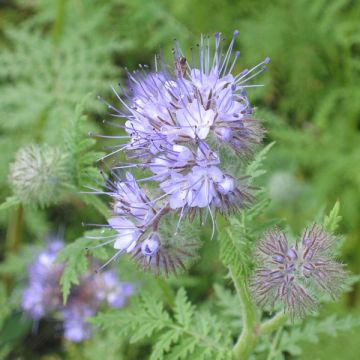

Nepeta grandiflora Border Ballet - Catnip
Nepeta grandiflora Border Ballet - Catnip
Nepeta grandiflora Border Ballet
This item cannot be shipped to the selected country
Dispatch by letter from €3.90
More information
Schedule delivery date,
and select date in basket
This plant carries a 6 months recovery warranty
More information
We guarantee the quality of our plants for a full growing cycle, and will replace at our expense any plant that fails to recover under normal climatic and planting conditions.
Seed-only orders are dispatched by sealed envelope. The delivery charge for seed-only orders is €3.90.
Does this plant fit my garden?
Set up your Plantfit profile →
Description
Nepeta grandiflora 'Border Ballet' is a superb garden plant, reliable, with endless flowering, melliferous, aromatic and fragrant. Its spike-shaped flowers are a bright violet-blue colour. Easy to sow, it blooms in the first year. Frugal and hardy, this perennial thrives in the sun, tolerating poor and rocky soils, or well-drained ordinary soils. This Nepeta enlivens wild gardens as well as those inspired by romance or the countryside, in borders, rockeries or pots.
Nepeta grandiflora is a rhizomatous perennial plant native to the Caucasus. It is found anchored in dry, stony and gravelly slopes or among rocks in medium mountain areas, up to the subalpine zone. Like other Nepetas, it is a plant of the mint family, strongly aromatic, containing essential oils responsible for its fragrance. The 'Border Ballet' variety offers flowering that can spread from June to October. It forms a small, spreading bush of about 35-40cm (14-16in) in all directions. The leafy flower stems, 60 to 90cm (24 to 35in) in height, with a quadrangular cross-section, are covered in fuzz. At the top, long spikes appear, with clusters of small bilabiate flowers in a bright violet-blue colour, nestled in dark violet bracts. Rich in nectar, they attract many pollinating insects. The foliage of this plant, more or less evergreen, is composed of very small wrinkled leaves in a dark green colour, rich in essential oils. When crushed, they release aromas of lemon and geranium, or even sweet and spicy notes. The flowering gives way to black or brown, ribbed fruits, which release numerous small seeds. They will easily germinate in light soil.
Nepeta grandiflora 'Border Ballet' belongs to the tribe of catmints. Easy to sow and cultivate, it is so accommodating and generous that it would be a shame not to enjoy it. Of good size, it has a place in all slightly informal gardens. It is essential in dry gardens, rockeries or in pots on terraces or balconies that you don't want to water too much. In sunny positions, it can be planted at the edge of flower beds in many regions, at the foot of roses, with asters and red shrub salvias.
Report an error about the product description
Flowering
Foliage
Plant habit
Botanical data
Nepeta
grandiflora
Border Ballet
Lamiaceae
Caucasus
Other Perennial flower seeds
Planting and care
Sowing:
Sow Nepeta seeds from February to June or from September to October. Sow in pots or in trays filled with moist special seed compost, covering the seeds with a pinch of compost or vermiculite. Keep at a temperature between 15 and 20 °C (59 and 68°F). After sowing, do not exclude light as it promotes germination. Keep the surface of the compost moist but not waterlogged; germination usually takes 7 to 21 days.
When the young plants are sufficiently developed, transplant them into 7.5cm (3in) pots or trays. Gradually acclimatize them to cooler conditions for a few days before placing them, after all risk of frost, spacing them 30cm (12in) apart. Choose a sunny spot with well-draining soil.
Cultivation:
A true all-terrain plant, Nepeta grandiflora grows in sunny areas with light, even poor, limestone and rocky soils. It appreciates moist soils but can adapt to summer drought by reducing its flowering. In heavy soils, dig a hole 3 times larger than the volume of the bucket and mix 1/3 gravel and 1/3 sand with your topsoil to lighten the soil and prevent waterlogging in winter. In the heart of summer, after the first wave of flowering, you can prune the faded inflorescences to a height of 20cm (8in) if necessary, using shears. The plant will become more compact and will bloom again in autumn.
Sowing period
Intended location
This item has not been reviewed yet - be the first to leave a review about it.
Flower seeds
Haven't found what you were looking for?
Hardiness is the lowest winter temperature a plant can endure without suffering serious damage or even dying. However, hardiness is affected by location (a sheltered area, such as a patio), protection (winter cover) and soil type (hardiness is improved by well-drained soil).

Photo Sharing Terms & Conditions
In order to encourage gardeners to interact and share their experiences, Promesse de fleurs offers various media enabling content to be uploaded onto its Site - in particular via the ‘Photo sharing’ module.
The User agrees to refrain from:
- Posting any content that is illegal, prejudicial, insulting, racist, inciteful to hatred, revisionist, contrary to public decency, that infringes on privacy or on the privacy rights of third parties, in particular the publicity rights of persons and goods, intellectual property rights, or the right to privacy.
- Submitting content on behalf of a third party;
- Impersonate the identity of a third party and/or publish any personal information about a third party;
In general, the User undertakes to refrain from any unethical behaviour.
All Content (in particular text, comments, files, images, photos, videos, creative works, etc.), which may be subject to property or intellectual property rights, image or other private rights, shall remain the property of the User, subject to the limited rights granted by the terms of the licence granted by Promesse de fleurs as stated below. Users are at liberty to publish or not to publish such Content on the Site, notably via the ‘Photo Sharing’ facility, and accept that this Content shall be made public and freely accessible, notably on the Internet.
Users further acknowledge, undertake to have ,and guarantee that they hold all necessary rights and permissions to publish such material on the Site, in particular with regard to the legislation in force pertaining to any privacy, property, intellectual property, image, or contractual rights, or rights of any other nature. By publishing such Content on the Site, Users acknowledge accepting full liability as publishers of the Content within the meaning of the law, and grant Promesse de fleurs, free of charge, an inclusive, worldwide licence for the said Content for the entire duration of its publication, including all reproduction, representation, up/downloading, displaying, performing, transmission, and storage rights.
Users also grant permission for their name to be linked to the Content and accept that this link may not always be made available.
By engaging in posting material, Users consent to their Content becoming automatically accessible on the Internet, in particular on other sites and/or blogs and/or web pages of the Promesse de fleurs site, including in particular social pages and the Promesse de fleurs catalogue.
Users may secure the removal of entrusted content free of charge by issuing a simple request via our contact form.
The flowering period indicated on our website applies to countries and regions located in USDA zone 8 (France, the United Kingdom, Ireland, the Netherlands, etc.)
It will vary according to where you live:
- In zones 9 to 10 (Italy, Spain, Greece, etc.), flowering will occur about 2 to 4 weeks earlier.
- In zones 6 to 7 (Germany, Poland, Slovenia, and lower mountainous regions), flowering will be delayed by 2 to 3 weeks.
- In zone 5 (Central Europe, Scandinavia), blooming will be delayed by 3 to 5 weeks.
In temperate climates, pruning of spring-flowering shrubs (forsythia, spireas, etc.) should be done just after flowering.
Pruning of summer-flowering shrubs (Indian Lilac, Perovskia, etc.) can be done in winter or spring.
In cold regions as well as with frost-sensitive plants, avoid pruning too early when severe frosts may still occur.
The planting period indicated on our website applies to countries and regions located in USDA zone 8 (France, United Kingdom, Ireland, Netherlands).
It will vary according to where you live:
- In Mediterranean zones (Marseille, Madrid, Milan, etc.), autumn and winter are the best planting periods.
- In continental zones (Strasbourg, Munich, Vienna, etc.), delay planting by 2 to 3 weeks in spring and bring it forward by 2 to 4 weeks in autumn.
- In mountainous regions (the Alps, Pyrenees, Carpathians, etc.), it is best to plant in late spring (May-June) or late summer (August-September).
The harvesting period indicated on our website applies to countries and regions in USDA zone 8 (France, England, Ireland, the Netherlands).
In colder areas (Scandinavia, Poland, Austria...) fruit and vegetable harvests are likely to be delayed by 3-4 weeks.
In warmer areas (Italy, Spain, Greece, etc.), harvesting will probably take place earlier, depending on weather conditions.
The sowing periods indicated on our website apply to countries and regions within USDA Zone 8 (France, UK, Ireland, Netherlands).
In colder areas (Scandinavia, Poland, Austria...), delay any outdoor sowing by 3-4 weeks, or sow under glass.
In warmer climes (Italy, Spain, Greece, etc.), bring outdoor sowing forward by a few weeks.

































